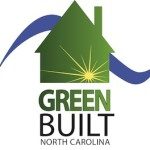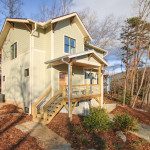
We have entered the finishing phase of our latest home. There is the long stretch of details still ahead though all of the major and most of the minor decisions are made. (Often the hardest work) Our Energy efficiency plan has been carried out and the HERS rater (Vandemusser Design) will put it to the tests. We should have no trouble getting a HERS score of under 55 which will qualify to get the $4000. HERO rebate through Duke Energy’s Residential New Construction Program. (Previous post on HERO https://bit.ly/1cUGsYx )
Most of the energy efficiency part of Green Built NC is covered in the Energy Star Home program that is a prerequisite. While Green Built NC emphasizes the importance of energy use it also covers much more which is why it is a more valuable program than just Energy Star. It addresses water use, Indoor Air Quality, resource use and site issues. The website https://www.wncgbc.org/programs/green-built explains it all from the steps involved in certifying a home to the checklist and resources to help you get through the process. To get a good sense of what the program covers check out the checklist, a spreadsheet doc that covers all the options for meeting the programs requirements in the different categories. It is an educational tool as well as the functional part of the program.
A sustainable home will be more than energy efficient. If it does not provide good indoor air quality it will not sustain the people who live in it. Radon is one of the most obvious issues. Green Built NC requires a radon test and an acceptable level of Radon. It is relatively easy to meet this with a radon vent that is either passive or active depending on what is needed as long as it is installed during the rough in stage. It also covers ventilation requirements and product choices to keep the air healthy for humans.
Resource use or”materials opportunities” includes choosing products such as FSC lumber, recycled materials or sustainably harvested wood from the site. Also reducing waste and recycling as much material as possible that is not used. It is important to make building the house a sustainable process. We can’t build sustainable homes while depleting the resources needed to make them.
Site work and sustainable landscaping are sometimes the most obvious aspects of a Green Built home. Using indigenous and non-invasive plants as well as adapting the site for storm water events are important for the site itself and the water quality of our streams and rivers that the storm water drains into.
There is also Water efficiency. “Water efficiency is the smart use of our water resources through water-saving technologies and simple steps we can all take around the house. Using water efficiently will help ensure reliable water supplies today and for future generations.” https://1.usa.gov/1Pa7OrH
This is obviously a condensed look at the GreenBuiltNC program but hopefully conveys a sense of the scope of the program. If you are looking to build or buy it is worth checking out. Also if you missed it there was a great article by the Mountain Xpress about the 1000th certified house through the program. https://bit.ly/1DAazNF

boone guyton

